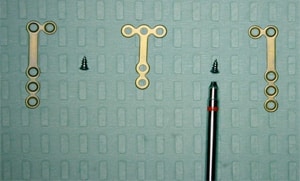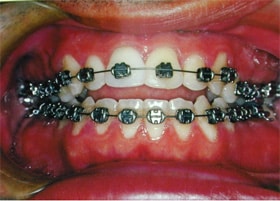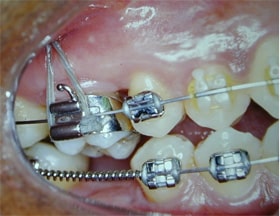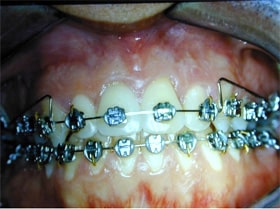Historically, closure of a skeletal open bite (apertognathia) often required a combination of orthodontics and orthognathic surgery to achieve correction of the occlusion and esthetic improvement. When traditional jaw surgery is not an option, the use of titanium plates and screws along with orthodontics can consistently and predictably reposition and intrude posterior teeth for stable dental and skeletal correction.
If you are interested in learning about the benefits of skeletal anchorage surgery, or if you wish to determine whether you are a candidate for treatment, call Dr. Leslie Sultan today for a personalized consultation. Dial (954) 771-8772 to reach our Fort Lauderdale office and speak with our staff!
Patient Testimonial
“Everyone in this office is friendly, helpful, and professional. Dr. Sultan is a very competent and kind oral surgeon. He immediately made me feel at ease, and explained how he could help. He completed the procedure quickly and painlessly, and the office followed up afterward to make sure my recovery went well. Cannot recommend highly enough.” – Jim C.
What Is The Skeletal Anchorage System?
The skeletal anchorage system consists of titanium anchor plates and screws that are temporarily placed in the jaw to allow orthodontic tooth movement previously impossible with conventional orthodontics. These systems are designed for use as an anchor in orthodontic procedures such as intrusion/extrusion of teeth, space closure, distal/mesial movement, and 3D control of teeth.
The problem with orthodontic treatments is finding ways to move the necessary teeth while minimizing the unwanted reciprocal movement of the teeth they pull or push against. The skeletal anchorage system allows the anchoring to come from the jawbone, not other teeth. This is used for patients with moderate to severe skeletal discrepancies. Skeletal anchorage can allow Dr. Sultan and your orthodontist to move the patient’s teeth and avoid needing jaw surgery.
Who Would Be A Good Candidate For Skeletal Anchoring?
Patients with relatively severe orthodontic movement needs are candidates for skeletal anchoring. This system allows Dr. Sultan to:
- Close spaces with missing teeth in lieu of placing dental implants
- Bring severely impacted molars back upright and into normal occlusion
- Safely and comfortably erupt impacted canines
- Correct occlusal plane cants
- Solve difficult tooth eruption problems
- Eliminate jaw surgery in some cases
Indications for Skeletal Anchorage:
- To correct open bite by distalizing and intruding posterior teeth
- Retract and intrude anterior teeth
- Extrude deeply impacted molars

Advantages of Skeletal Anchorage over traditional Orthognathic Surgery:
- Placement of plates and screws can be performed in office with local or IV sedation
- Immediate loading, or use of plates to move teeth
- Total treatment time 6-9 months average
- Avoidance of major surgery and headgear
How Is Skeletal Anchorage Performed?
Installing these systems involves only minor surgery in our Ft. Lauderdale offices. Planning of these procedures uses panoramic x-rays and discussions between Dr. Sultan and your orthodontist.
Dr. Sultan places the titanium anchor plates in the maxilla, the upper jaw, where there is adequate bone thickness for stable placement. He is careful to avoid the tooth roots in the area. In the mandible, the lower jawbone, he must avoid the mental nerve. In the upper jaw, Dr. Sultan makes a vertical incision from 8-10 mm in length from the mucogingival junction into the maxillary vestibule. This gains access to the bone. At this point, he adapts the anchor device, so the plate and the connecting bar closely follow the contour of the bone. The anchor plate is then placed with two or three screws, and the incision is closed. In some cases, only screws are used for anchorage and not a plate. These placements of the anchor plates and screws are not overly difficult and can be done with the patient under only local or IV sedation.
The device is activated about 7 days after the placement surgery. This allows for adequate healing at the site of the tissue flap and at the soft tissue where the connecting bar is located.
Please discuss the use of Skeletal Anchorage with your orthodontist and Dr. Sultan to see whether it is a viable option in your treatment.




How Long Do Patients Have To Wear The Skeletal Anchorage System?
Using skeletal anchoring in lieu of orthognathic surgery allows the patient to avoid the trauma and recovery of major surgery and the need for headgear. Total treatment time averages only 6-9 months.
Is The Skeletal Anchorage System Painful?
Pain and discomfort are not extreme with the mini screw placement. There is more discomfort due to the anchor plate, as it requires more soft tissue dissection. Patients will also have some cheek irritation, and this tends to peak around 10 days after surgery before fully resolving.
Consider the recovery necessary for jawbone surgery, which would be the alternative to skeletal anchorage, the discomfort, and recovery from this procedure is minimal
What Are The Potential Risks With The Skeletal Anchorage System?
The main risks of skeletal anchorage systems are with infection after placement of the anchor screws or anchor plates. Patients are put on a 5-day course of oral antibiotics after these surgeries.
Beyond that, there is potential for failure of the anchorage screws and the anchoring plates. The experience and expertise of Dr. Sultan minimizes problems with either of these areas. The screws can loosen, especially if the bone mass of the maxilla or mandible is not sufficient. But Dr. Sultan carefully plots these positions to minimize this possibility.
There is potential for damage to the tooth roots in the area, along with nerves, but these are rare.
See What Our Patients Have To Say…
“Dr. Sultan’s staff has been very helpful and nice. My procedure has gone very well and I am happy with Doctor Sultan’s work and results. I would highly recommend Dr. Sultan for any dental work that requires an expert.” – Tracy F.
How Do I Know if Skeletal Anchorage Is Right for Me?
After an in-depth examination with Dr. Sultan and after a review of your orthodontic history, you and Dr. Sultan will decide if skeletal anchorage is right for you. Candidacy for this procedure depends on your current orthodontic needs and your response to other forms of treatment in the past.
How Do I Take Care of My Skeletal Anchorage Device?
Dr. Sultan will provide you with detailed instructions on how to take care of your anchorage devices. It is important that you continue to perform proper oral hygiene to reduce the risk of infection. You should also avoid food that is sticky or overly chewy in texture.
Is Skeletal Anchorage Right for Everyone?
As mentioned above, candidacy for skeletal anchorage depends on your orthodontic needs, your previous response to other treatments, and your understanding of what the procedure can and cannot accomplish.
Contact Dr. Sultan For A Skeletal Anchorage Surgery In Fort Lauderdale!
If you’re interested in learning more about skeletal anchorage please contact Dr. Leslie Sultan for a consultation at 954.771.8772 or fill out our contact us form. At Sultan Center For Oral Facial Surgery, we will discuss your needs and concerns, and determine your best course of action.

